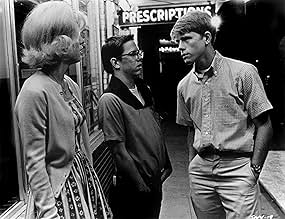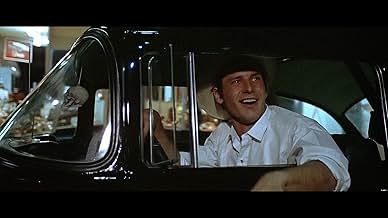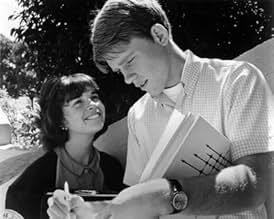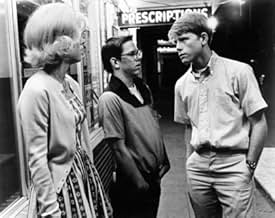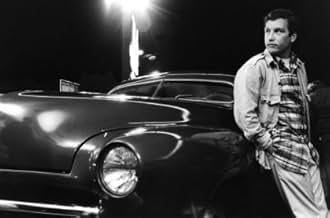Un paio di studenti delle scuole superiori passano un'ultima notte in crociera con i loro amici prima di andare al college.Un paio di studenti delle scuole superiori passano un'ultima notte in crociera con i loro amici prima di andare al college.Un paio di studenti delle scuole superiori passano un'ultima notte in crociera con i loro amici prima di andare al college.
- Regia
- Sceneggiatura
- Star
- Candidato a 5 Oscar
- 9 vittorie e 13 candidature totali
Ron Howard
- Steve
- (as Ronny Howard)
Charles Martin Smith
- Terry
- (as Charlie Martin Smith)
Terence McGovern
- Mr. Wolfe
- (as Terry McGovern)
Kathleen Quinlan
- Peg
- (as Kathy Quinlan)
Recensioni in evidenza
I don't know if George Lucas really knew what he had in this picture--surely the screenplay seemed funny enough, and the thought of the cars and the period music was enticing--but did he really know these "unknown" actors would bring these characters to life? It seems almost a fluke, shot in 29 days and on a tight budget, but "American Graffiti" is a classic. It is perhaps pure nostalgia, mixing pathos and humor, sadness and craziness, hope and reflection in quiet little bursts of excitement. After cruising with Milner all night, teenage Carol hates to say goodbye but does, waving from her porch with the light on; Toad survives one bad accident after another, but his real moment is in hearing praise from his date (fantastic, husky-voiced Candy Clark, dolled up like a speeding Sandra Dee) just before she says good night; after chasing his dream date all night, Kurt (Richard Dreyfuss, green and anxious, and appealingly bemused) finally gets to talk to the stunning blonde wonder on the telephone, where she whispers a wrenching goodbye. The whole movie is steeped in reflection. It has great, great humor, yet it leaves one with a bittersweet melancholia. For yesterday is in the past, with our music, our memories and our hesitant farewells. ***1/2 from ****
Whether you love this movie or not, you have to admire this movie for two reasons. First, its return on the dollar was among the best ever for any film. While the budget was a very modest $777,777.111 (no kidding), it returned $115,000,000 in the United States alone! No wonder this film made George Lucas famous. Second, it was very innovative. While I was not a huge fan of the film's style, it was unique and sure had an impact on the world as well as future films. No one had made a film like this before--chock full of one song after another blaring across the soundtrack and its odd semi-structureless plot was also quite unique.
The film concerns a bunch of young adults just hanging out and cruising. There really isn't a lot more to it than that. Sure, their stories all reveal a bit about them through the course of the film, but most of the characters have no great depth. It's more like you are a voyeur watching some likable and not especially likable kids doing...well...nothing. Now if you grew up in the early 60s and remember all this, then it's a great stroll down memory lane. If you didn't, I think the movie will be more of a tough sell, as the nostalgia angle is non-existent. As for me, I wasn't even born until 1964, so the nostalgia aspect was less--but I loved the music and great cars. My daughter, while less impressed about EVERYTHING did grudgingly say that the music was great. She also said that she pretty much ignored the plot and just listened to the songs! And, perhaps, this is pretty typical of a person from her generation. As for me, the film was mildly interesting and I respect it--though I did not love it. This isn't really meant as a criticism--just a statement about how this film appealed to this 47 year-old guy. For the right audience, it's the perfect film. Otherwise, you might feels it's all a bit overrated.
Aside from the nostalgia for the early 60s, the movie also is quite interesting when seen today because so many future stars and super-stars are in it--mostly when they were young unknowns. Ron Howard (a child star but not all that popular yet as an adult), Cindy Williams, Harrison Ford, Richard Dreyfus, Charles Martin Smith, Mackenzie Phillips and Suzanne Somers all appear in the film.
The film concerns a bunch of young adults just hanging out and cruising. There really isn't a lot more to it than that. Sure, their stories all reveal a bit about them through the course of the film, but most of the characters have no great depth. It's more like you are a voyeur watching some likable and not especially likable kids doing...well...nothing. Now if you grew up in the early 60s and remember all this, then it's a great stroll down memory lane. If you didn't, I think the movie will be more of a tough sell, as the nostalgia angle is non-existent. As for me, I wasn't even born until 1964, so the nostalgia aspect was less--but I loved the music and great cars. My daughter, while less impressed about EVERYTHING did grudgingly say that the music was great. She also said that she pretty much ignored the plot and just listened to the songs! And, perhaps, this is pretty typical of a person from her generation. As for me, the film was mildly interesting and I respect it--though I did not love it. This isn't really meant as a criticism--just a statement about how this film appealed to this 47 year-old guy. For the right audience, it's the perfect film. Otherwise, you might feels it's all a bit overrated.
Aside from the nostalgia for the early 60s, the movie also is quite interesting when seen today because so many future stars and super-stars are in it--mostly when they were young unknowns. Ron Howard (a child star but not all that popular yet as an adult), Cindy Williams, Harrison Ford, Richard Dreyfus, Charles Martin Smith, Mackenzie Phillips and Suzanne Somers all appear in the film.
American Graffiti, voted in 1998 to the American Film Institute's list of 100 superlative films, is as good today as it was upon its release in 1973. Countless films (such as Linklater's excellent Dazed and Confused) have borrowed heavily from Lucas' blueprint of multiple characters and storylines punctuated by wall to wall rock music. If possible, you should try to see the 1998 documentary that accompanies the DVD release, as it provides a wealth of information directly from Lucas, Coppola, LeMat, Ford, Clark, Dreyfuss, Howard, and many others about the creation of the film from concept to box-office phenomenon.
The summer of 1962, for these four Youths, it's the closest they will ever get to the Garden of Eden. The music, the cars, the drinking, the dancing, and the innocence, American Graffiti is a harder film to make than Star Wars. To identify with the generation and to create truth from the characters, George Lucas's masterpiece is American Graffiti. From the town Big shot, the future Race car Driver, the Perfect Couple, and the local Nerd, it is amazing how the audience identifies with all these characters from out past. Like a page out of the high school year book, this movie jumps back into the early 60's, before the war, before the lines were drawn, the age of innocence in America would soon be coming to an end. This is the last party of the summer before the dream finally ends.
I was born at the beginning of the next decade--1970--yet "American Graffiti" was a chord that rippled throughout my life.
My father, who, like George Lucas, grew up in California's Central Valley, said this movie perfectly captured what it was like to grow up there--street cruising, hot rodding, picking up chicks, pulling pranks. Though this movie necessarily sidesteps the boredom inherent in growing up in the pesticide-choked San Joaquin Valley, the place itself is not as important the time it explores. It was a time just before the 1960s descended into the beginning of the end of American culture--the prototypical middle America that existed in almost all its small towns and now has substantively disappeared thanks to the urbanization and suburbanization of much of this country.
The ensemble cast, including so many that went on to become hugely successful in Hollywood--Ron Howard, Cindy Williams (well, with Laverne & Shirley at least), Richard Dreyfuss, and of course Harrison Ford (not to mention Lucas himself)--is handled with great skill from such a young director and reinforces the mystery why Lucas has so horribly mishandled Star Wars Eps. I and II. Lucas simply has been at the Ranch too long and his brilliant career has arrived parked in the garage at a large, entirely perfunctory business and media empire.
Anyway, regardless of Lucas' drift far away from the cutting edge, "American Graffiti" still stands as a kind of monument to his precocity. It is the kind of movie that hits every note with effortless precision, which I think is less the effort of great editing as it is a combination of youthful exuberance and actors and a director at essentially the beginning of their ascent as some of the best in the business.
This movie also withstands the test of time simply because it works magically both for those who have no particular emotional connection to the '60s and for those who were there on nearly equal levels. There is tremendous humor and naturalistic character play and dialog that few can help but be drawn into. Anyone with any sense of history will acknowledge that all the characters are standing at the edge of the deflowering and self-destruction of America in the '60s. It is a time of tremendous innocence, change, and harrowing decisions. The Bay of Pigs, Cuban Missile Crisis, and Vietnam haven't happened yet.
With Iraq and terrorism chewing at our consciousness every day, it's pretty easy for modern youth to identify and yearn for the nostalgia of such innocence.
My father, who, like George Lucas, grew up in California's Central Valley, said this movie perfectly captured what it was like to grow up there--street cruising, hot rodding, picking up chicks, pulling pranks. Though this movie necessarily sidesteps the boredom inherent in growing up in the pesticide-choked San Joaquin Valley, the place itself is not as important the time it explores. It was a time just before the 1960s descended into the beginning of the end of American culture--the prototypical middle America that existed in almost all its small towns and now has substantively disappeared thanks to the urbanization and suburbanization of much of this country.
The ensemble cast, including so many that went on to become hugely successful in Hollywood--Ron Howard, Cindy Williams (well, with Laverne & Shirley at least), Richard Dreyfuss, and of course Harrison Ford (not to mention Lucas himself)--is handled with great skill from such a young director and reinforces the mystery why Lucas has so horribly mishandled Star Wars Eps. I and II. Lucas simply has been at the Ranch too long and his brilliant career has arrived parked in the garage at a large, entirely perfunctory business and media empire.
Anyway, regardless of Lucas' drift far away from the cutting edge, "American Graffiti" still stands as a kind of monument to his precocity. It is the kind of movie that hits every note with effortless precision, which I think is less the effort of great editing as it is a combination of youthful exuberance and actors and a director at essentially the beginning of their ascent as some of the best in the business.
This movie also withstands the test of time simply because it works magically both for those who have no particular emotional connection to the '60s and for those who were there on nearly equal levels. There is tremendous humor and naturalistic character play and dialog that few can help but be drawn into. Anyone with any sense of history will acknowledge that all the characters are standing at the edge of the deflowering and self-destruction of America in the '60s. It is a time of tremendous innocence, change, and harrowing decisions. The Bay of Pigs, Cuban Missile Crisis, and Vietnam haven't happened yet.
With Iraq and terrorism chewing at our consciousness every day, it's pretty easy for modern youth to identify and yearn for the nostalgia of such innocence.
The Life and Times of Harrison Ford
The Life and Times of Harrison Ford
Take a look back at Harrison Ford's movie career in photos.
Lo sapevi?
- QuizDue to the low budget, George Lucas was unable to pay all of the crew members. He offered to give many of them a screen credit in lieu of payment, and they accepted. Traditionally, only department heads received screen credit. Giving screen credit to all crew members is now standard, which is why closing credits last so much longer now.
- BlooperThe movie is set in 1962, but a cinema marquee advertises Terrore alla 13ª ora (1963) (released in 1963). This was done on purpose by George Lucas, because Dementia 13 was Producer Francis Ford Coppola's first movie.
- Citazioni
Curt Henderson: You're the most beautiful, exciting thing I've ever seen in my life and I don't know anything about you.
- Curiosità sui creditiWorded epilogues prior to the credits shows what happen to the characters following the movie. While this has since become commonplace in films, it was considered innovative at the time.
- Versioni alternativeOriginally released at 110 minutes; re-edited and re-released in a slightly longer version (112 minutes) in 1978 when many of its then-unknown stars became famous.
- ConnessioniFeatured in Airport 75 (1974)
- Colonne sonoreAt The Hop
Written by John Madara, Artie Singer and Dave White (uncredited)
Performed by Flash Cadillac (as Flash Cadillac and The Continental Kids)
Produced by Kim Fowley
Courtesy of Roulette Records:
I più visti
Accedi per valutare e creare un elenco di titoli salvati per ottenere consigli personalizzati
Dettagli
- Data di uscita
- Paese di origine
- Lingua
- Celebre anche come
- American Graffiti: Locura de verano
- Luoghi delle riprese
- Aziende produttrici
- Vedi altri crediti dell’azienda su IMDbPro
Botteghino
- Budget
- 750.000 USD (previsto)
- Lordo Stati Uniti e Canada
- 115.000.000 USD
- Lordo in tutto il mondo
- 115.006.690 USD
- Tempo di esecuzione1 ora 50 minuti
- Colore
- Proporzioni
- 2.39 : 1
Contribuisci a questa pagina
Suggerisci una modifica o aggiungi i contenuti mancanti






